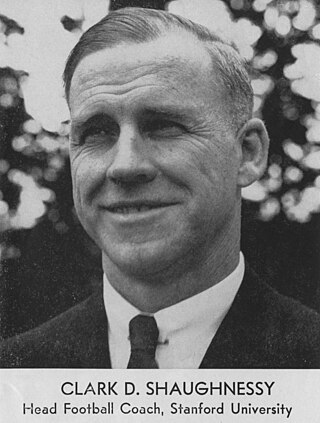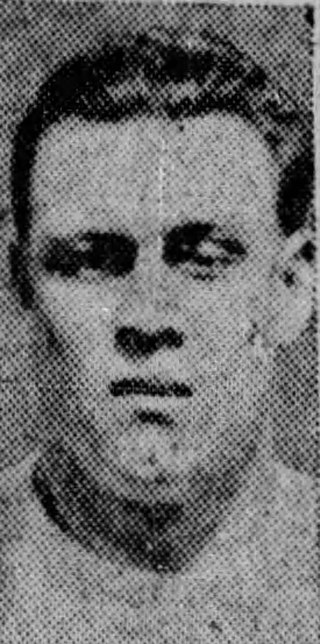Related Research Articles

Ernest Alonzo Nevers, nicknamed "Big Dog", was an American professional football and baseball player and football coach. Widely regarded as one of the best football players in the first half of the 20th century, he played as a fullback and was a triple-threat man known for his talents in running, passing, and kicking. He was inducted with the inaugural classes of inductees into both the College Football Hall of Fame in 1951 and the Pro Football Hall of Fame in 1963. He was also named in 1969 to the NFL 1920s All-Decade Team.
The 1977 Stanford Cardinals football team represented Stanford University in the Pacific-8 Conference during the 1977 NCAA Division I football season. Led by first-year head coach Bill Walsh, Stanford ended the regular season with an 8–3 record.
The 1978 Stanford Cardinals football team represented Stanford University in the Pacific-10 Conference during the 1978 NCAA Division I-A football season. Led by second-year head coach Bill Walsh, the Cardinals were 7–4 in the regular season and played their home games on campus at Stanford Stadium in Stanford, California. Their four losses were by a combined total of sixteen points.

The 1926 Stanford Indians football team was an American football team that represented Stanford University in the Pacific Coast Conference (PCC) during the 1926 college football season. In head coach Pop Warner's third season at Stanford, the team compiled a 10–0 record during the regular season, outscored its opponents by a total of 261 to 66, and won the PCC championship. Stanford then faced undefeated Alabama in the 1927 Rose Bowl, which ended in a 7–7 tie.

The 1941 Stanford Indians football team represented Stanford University as a member of the Pacific Coast Conference (PCC) during the 1941 college football season. Second-year head coach Clark Shaughnessy led the team to a 6–3 record. Before the season, Stanford, which the year prior had finished 10–0, was considered a favorite for the national championship, but three conference losses put it out of contention for a return to the Rose Bowl. After the season, Shaughnessy left Stanford to take over as head coach at the University of Maryland.
The 1947 Stanford Indians football team was an American football team that represented Stanford University in the Pacific Coast Conference (PCC) during the 1947 college football season. In its third year under head coach Marchmont Schwartz, the team compiled a 0–9 record, finished last in the PCC, and was outscored by a total of 214 to 73.
The 1927 Stanford football team represented Stanford University in the 1927 college football season. In head coach Pop Warner's fourth season, Stanford was undefeated in the Pacific Coast Conference, with a tie in the game against USC. With a three-way tie for the conference championship, Stanford was chosen to represent the conference in the 1928 Rose Bowl against Pittsburgh, with Stanford winning its first Rose Bowl in its fourth attempt, 7–6.
The 1924 Stanford football team represented Stanford University as a member of the Pacific Coast Conference (PCC) during 1924 college football season. Led by first-year head coach was Pop Warner, Stanford compiled an overall record of 7–1–1 with a mark of 3–0–1 in conference play, winning the program's first PCC title. Stanford made its second bowl game appearance, losing to Notre Dame in the Rose Bowl].
The 1925 Stanford football team was an American football team that represented Stanford University as a member of the Pacific Coast Conference (PCC) during the 1925 PCC football season. In its second season under head coach Pop Warner, Stanford compiled a 7–2 record and finished second in the PCC. Its only conference loss was against conference champion Washington. The team played its home games at Stanford Stadium in Stanford, California. The team was ranked No. 8 in the nation in the Dickinson System ratings released in January 1926.
The 1932 Stanford Indians football team was an American football team that represented Stanford University in the Pacific Coast Conference (PCC) during the 1932 college football season. In its ninth and final season under head coach Pop Warner, the team compiled a 6–4–1 record, finished in seventh place in the PCC, and outscored opponents by a total of 171 to 58.

George Richardson Bogue was an American football player.
The 1946 Stanford Indians football team was an American football team that represented Stanford University in the Pacific Coast Conference (PCC) during the 1946 college football season. This was the team's first season since 1942 because the team suspended play for three years due to World War II. Stanford's head coach was Marchmont Schwartz, who had coached the 1942 team as well. The team compiled a 6–3–1 record and outscored all opponents by a total of 222 to 147.
The 1931 Stanford football team represented Stanford University in the 1931 college football season. Their head coach was Pop Warner in his eighth season. The team played its home games at Stanford Stadium in Stanford, California. This was the first year the team was officially known as the "Indians." The team had been referred to by that nickname for some time, but the mascot was officially adopted by a unanimous vote by the Executive Committee for the Associated Students at the end of the previous football season.
The 1921 Stanford football team represented Stanford University in the 1921 college football season. They were coached by Eugene Van Gent in his only season as head coach. The team played most of its home games at the 15,000-seat Stanford Field while construction on the new 60,000-seat Stanford Stadium was being completed. Stanford Stadium officially opened for the final game, the Big Game against California, in which the Bears defeated Stanford 42–7.
The 1930 Dartmouth Indians football team was an American football team that represented Dartmouth College as an independent during the 1930 college football season. In their fourth season under head coach Jackson Cannell, the Indians compiled a 7–1–1 record, shut out five of nine opponents, and outscored opponents by a total of 301 to 43.

The 1930 California Golden Bears football team was an American football team that represented the University of California, Berkeley during the 1930 college football season. Under head coach Nibs Price, the team compiled an overall record of 4–5 and 1–4 in conference.
The 1938 Santa Clara Broncos football team was an American football team that represented Santa Clara University as an independent during the 1938 college football season. In their third season under head coach Buck Shaw, the Broncos compiled a 6–2 record and outscored opponents by a total of 97 to 26. They were ranked as high as No. 5 in the AP Poll before losing the last two games of the season.
The 1930 Santa Clara Broncos football team was an American football team that represented Santa Clara University as an independent during the 1930 college football season. In their second season under head coach Maurice J. "Clipper" Smith, the Broncos compiled a 5–3–1 record and outscored opponents by a total of 151 to 54.
The 1952 Santa Clara Broncos football team was an American football team that represented the University of Santa Clara as an independent during the 1952 college football season. In their third season under head coach Richard F. Gallagher, the independent Broncos compiled a 2–6–1 record and were outscored 182 to 80. Their three home games were played off campus in San Francisco, Lodi, and Sacramento.
The 1925 Pacific Coast Conference football season was the 11th season of college football played by the member schools of the Pacific Coast Conference (PCC) and was a part of the 1925 college football season.
References
- ↑ "Stanford Game-by-Game Results; 1930–1934". College Football Data Warehouse. Archived from the original on October 6, 2014. Retrieved September 30, 2014.
- ↑ "Indian Symbol To Replace 'Cardinal;' Considered More Appropriate". The Stanford Daily. November 26, 1930. Retrieved September 8, 2022.
- ↑ "What is the history of Stanford's mascot and nickname?". Stanford Athletics website. Archived from the original on September 24, 2015. Retrieved September 24, 2014.
- ↑ "Stanford whips Army gridders, 32–0". The San Francisco Examiner. September 21, 1930. Retrieved May 22, 2022– via Newspapers.com.
- ↑ "Stanford beats Olympics 18–0". Eugene Register. September 28, 1930. Retrieved May 22, 2022– via Newspapers.com.
- ↑ Abe Kemp (October 5, 1930). "Stanford Trounces Santa Clara, 20-0: Broncos Put Up Tough Battle Against 'Pop' Warner's Men; 26,000 See Contest". The San Francisco Examiner. p. 35 – via Newspapers.com.
- ↑ "Minnesota gridders hold Stanford to scoreless tie". The San Francisco Examiner. October 12, 1930. Retrieved May 21, 2022– via Newspapers.com.
- ↑ "Drive by O.S.C. jars Stanford". The Spokesman-Review. October 19, 1930. Retrieved May 22, 2022– via Newspapers.com.
- ↑ "Trojans defeat Stanford, 41–12". Oakland Tribune. October 26, 1930. Retrieved May 22, 2022– via Newspapers.com.
- ↑ "Robert Leads Stanford Card to 20 to 0 win over U.C.L.A." The Fresno Morning Republican. November 1, 1930. Retrieved May 22, 2022– via Newspapers.com.
- ↑ "Fighting Huskies fall before Pop Warner's rejuvenated Stanford team". The Sunday Missoulian. November 9, 1930. Retrieved May 22, 2022– via Newspapers.com.
- ↑ "Cards' passes click on Tech". The San Francisco Examiner. November 16, 1930. Retrieved May 22, 2022– via Newspapers.com.
- ↑ "Stanford triumphs, California bows to Cards". The Los Angeles Times. November 23, 1930. Retrieved May 22, 2022– via Newspapers.com.
- ↑ "Dartmouth unable to match Stanford's smashing finish and bows, 14 to 7". Hartford Courant. November 30, 1930. Retrieved May 22, 2022– via Newspapers.com.